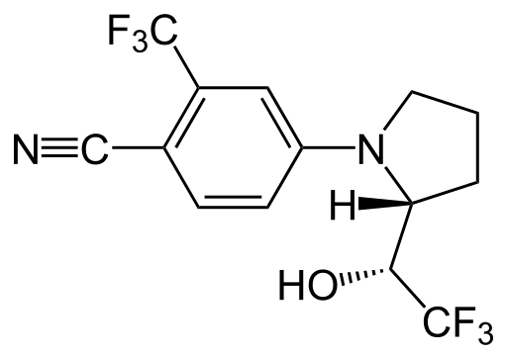
LGD-4033 has the legal status of being an Investigational New Drug – it is a SARM (selective androgen receptor modulator) that has great potential for treating diseases such as osteoporosis and sarcopenia, muscular dystrophy and muscle wasting associated with cancer and acute and chronic illnesses.
Unlike steroids, SARMs do not have potential adverse effects of testosterone on the prostate, as they display tissue-selective androgenic signalling, resulting in safer outcomes than steroids, in the body.
Initially discovered by Ligand Pharmaceuticals, Ligandrol is now being developed by Viking Therapeutics, with pre-clinical trials showing great promise.

A pre-clinical trial was done over a 13 week period, where cynomolgus monkeys were administered daily doses ranging from 0 – 75mg/kg. Both males and females gained significant body weight. After a period of 48 days, toxicity became a concern regarding those monkeys receiving 75mg/kg doses. However, this wasn’t a critical concern as the dose was significantly higher than would be administered in the clinical trials.
In essence, LGD-4033 was shown to increase bone mineral density, femur bending strength, and periosteal bone formation, in pre-clinical models.
Clinical trials were then initiated in two phases.
The Phase 1 consisted of a randomized placebo-controlled study of 76 human male adults over 21 days, with the primary aim being to establish safety and tolerability rather than efficacy.
The doses varied from placebo, to 0.1, 0.3 or 1.0 mg LGD-4033 with close measurements of body chemistries during and up to 5 weeks after administration.
An increase in lean body mass was evident without any indication of serious adverse events, and the frequency of adverse events was similar between the placebo and active groups – these being headache, dry mouth, and pain at the site of muscle biopsy.
At the 1.0 mg dosage there was associated signficant suppression of HDL cholesterol, and triglyceride levels – thus exhibiting the need for long term studies on SARM administration regarding cardiovascular risk. However for short term usage, the changes in HDL cholesterol may not be clinically important.
Lean body mass was shown to increase in correlation to dosage given, averaging 1.21kg at the 1.0mg dose, with fat mass remaining mostly unchanged.
The Phase 2 clinical trial was a randomized, double- blind, placebo-controlled, parallel group study, consisting of 120 patients who had undergone hip fracture surgery.
Over 12 weeks the patients were administered varying doses of 0.5 mg, 1.0 mg, 2.0 mg of LGD-4033, or else were administered a placebo, with the intention of evaluating the tolerability, efficacy and saftey of LGD-4033, and the effectiveness of LGD-4033 in increasing healthy lean body mass.
There are no available online results to this study as yet.

